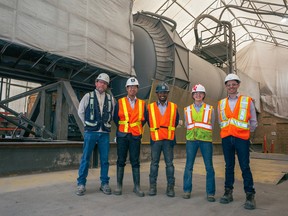
.
Another Calgary-born tech company is making big strides in global markets.
Announcement 2
.
Carbon Upcycling Technologies (CUT), the first company to reduce the carbon footprint of cement and concrete by double digits with its improved concrete admixtures, while improving strength activity performance by 40 percent, has drawn attention of the British government.
CEO Apoorv Sinha and his Calgary team have received CAD3.6 million in funding from UK Research Innovation to make climate-resistant cement from waste glass and CO2. This will be the world’s first commercial-scale cement additives plant that combines CO2 capture and waste glass.
The pilot will sequester up to five tons of CO2 emissions per day produced at a post-consumer glass recycling facility, while extending the useful life of 50 tons of glass waste. This translates to the project removing approximately 16,500 tons of local crushed glass from entering landfills, while sequestering approximately 1,600 tons of carbon dioxide that would otherwise reach the atmosphere.
Announcement 3
.
Sinha was born in the state of Bihar in India, but in his early years he lived in Kuwait, where his father was, and still is, in the oil and gas industry, and he grew up immersed in it.
He chose a career in chemical engineering and earned his bachelor’s degree in chemical and biomolecular engineering from the Georgia Institute of Technology in Atlanta.
In 2010, Sinha moved to Calgary to continue his studies at the University of Calgary while working for a small oilfield service company. He became passionate about recycling and reducing the embodied carbon of everything we interact with, and in 2014, along with partners Greg Boser and Randy Cusson, he launched Carbon Upcycling Technologies.
After the Alberta government put out a challenge to solve CO2 emissions, Carbon Upcycling received a grant that allowed it to design and build a reactor vessel that, charged with CO2 gas and raw waste dust, rotates to break down the materials. , allowing CO2 to be absorbed into it to create enhanced additives.
Announcement 4
.
Attention has focused on supplying these additives to cement and concrete manufacturers. The use of complementary materials has been shown to give concrete a 40% improvement in strength activity and increased durability, with 40% better rebar protection.
Starting with additives that would fill a cookie jar, the Calgary plant can now produce 20 tons per day.
The reclaimed fly ash is shipped to the Calgary plant and, after processing the concrete admixtures into raw waste powder feedstock, is transported by truck or rail car to the cement/concrete plants.
The use of additives processed from captured CO2 has been proven in many applications including driveways, retaining walls and foundation pads. It also provides low-carbon material solutions for fertilizer and consumer product brands, and makes plastics more sustainable.
ad 5
.
The UK funding will support a consortium led by Carbon Recycling, which includes CEMEX UK, a leading provider of cement and ready-mix concrete, and Glass Technology Services.
Gonzalo Galindo, head of CEMEX Ventures, says: “Our goal is to reach net zero by 2050 and this project with Carbon Upcycling is an important milestone towards utilizing captured carbon to help achieve this goal.”
Sinha says: “By creating a valuable product from one of the glass industry’s most difficult waste streams and using cement flue gas directly in its process, Carbon Upcycling will provide the UK market with a low cost alternative. cost and low carbon emission to imported ones. cementitious materials.
Much of the initial funding to start up the company was through grants, but its success earlier this year attracted $6 million in funding led by Boston-based Clean Energy Ventures, a leading venture capital firm. that invests in startups that tackle the world’s most complex problems. and urgent problems.
ad 6
.
Sinha points out that there are more than 3,600 concrete plants around the world, and Carbon Upcycling is paving the way to scale its commercial carbon utilization technology at facilities in North America and Europe.
Grades:
Five new restaurants/food locations, managed by the Vintage Group: Fleetwood Lounge, Luca Restaurant, Pazzi Pizzeria, Mercato Italian Market and Treno Cafe, opened at The Oliver on 10the. Located on the corner of 10the avenue and 4the Street SW, are part of the Centron Group’s 862-unit residential complex.
David Parker appears regularly in the Herald. Read online at calgaryherald.com/business. He can be reached at 403-830-4622 or via email at [email protected].

